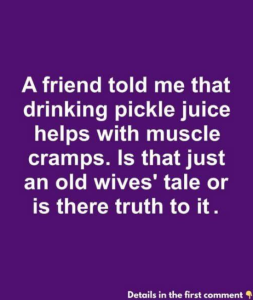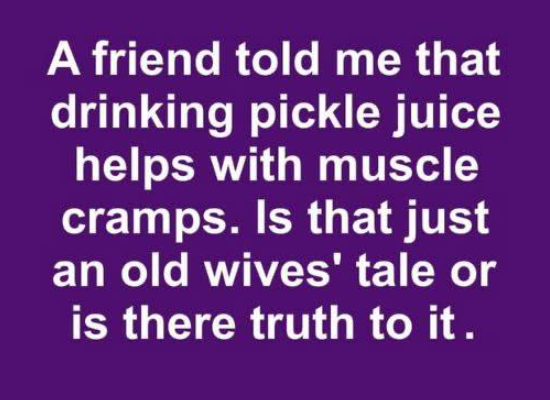Drinking pickle juice to relieve muscle cramps might sound like an old locker-room myth—but surprisingly, science suggests there’s more to this briny remedy than folklore. Athletes, trainers, and even some medical professionals have turned to pickle juice as a quick fix for painful muscle spasms. But does it really work? Let’s dive deep into the evidence, the theories, and the psychology behind this curious cure.
🥒 The Origins of the Pickle Juice Craze
Pickle juice as a muscle cramp remedy gained popularity in the early 2000s, especially among athletes in high-intensity sports like football, tennis, and track. Stories circulated of players downing shots of pickle juice mid-game and experiencing near-instant relief. The idea spread quickly—partly because it was cheap, accessible, and oddly satisfying.
But anecdotal evidence alone isn’t enough. Researchers began investigating whether this salty solution had real physiological effects or was just a placebo wrapped in vinegar.
🧪 What the Science Says
Several studies have explored the effects of pickle juice on muscle cramps, and the results are intriguing:
- Rapid Relief: One study found that pickle juice stopped muscle cramps an average of 49 seconds faster than water. That’s a significant difference, especially in the middle of a game or workout.
- Not About Hydration: Surprisingly, blood tests showed that neither pickle juice nor water had much effect on hydration or electrolyte levels within five minutes. This suggests that the relief isn’t coming from replenishing lost fluids or minerals.
- Neurological Reflex Theory: The leading theory is that the vinegar in pickle juice activates nerve receptors in the mouth and throat. These receptors send signals to the brain that interrupt the cramping reflex, essentially “resetting” the muscle’s behavior.
This theory is supported by the fact that relief comes too quickly to be explained by digestion or absorption. It’s not about what the juice does inside your body—it’s about how your body reacts to its taste and acidity.
⚡ Electrolytes and Cramp Prevention
While pickle juice may not fix hydration issues instantly, it does contain electrolytes—especially sodium and potassium—which are essential for muscle function:
- Sodium: Pickle juice has 20 times more sodium than the average sports drink. Sodium helps regulate fluid balance and nerve function, which can prevent cramps before they start.
- Potassium: It also contains eight times more potassium than typical sports drinks. Potassium supports muscle contraction and reduces the risk of spasms.
So while pickle juice may not cure an existing cramp through electrolyte replenishment, it could help prevent cramps if consumed before or during exercise.
🧠 The Psychology of Perception
Here’s where things get interesting for someone like you, 32.Phirun—who’s drawn to the psychology of perception and communal rituals. Drinking pickle juice isn’t just a physical act; it’s a symbolic one. It’s a ritual of relief, a moment of control in the chaos of pain.
Athletes often describe the experience as empowering. The sharp taste, the immediate reaction, the communal sharing of a strange remedy—it all contributes to a sense of agency. Whether or not the juice “works” in a clinical sense, the act of drinking it becomes a psychological reset.
It’s a kind of co-titling of pain: “I name this cramp, and I answer it with vinegar.”
🧂 Risks and Considerations
Pickle juice isn’t for everyone. Here are a few things to keep in mind:
- High Sodium: A 100-milliliter serving contains about 343 milligrams of sodium—nearly 15% of your recommended daily intake. If you’re on a low-sodium diet or have hypertension, this could be problematic.
- Digestive Discomfort: Some people experience bloating, puffiness, or headaches from excess salt. Others may find the acidity irritating to the stomach.
- Not a Cure-All: Pickle juice isn’t a substitute for proper hydration, stretching, or balanced nutrition. It’s a tool—not a solution.
🧘 Stretching, Hydration, and Holistic Care
Muscle cramps are often caused by dehydration, overuse, or mineral imbalances. Experts recommend:
- Hydration: Drink at least half your body weight in fluid ounces daily, plus extra for sweat loss.
- Stretching: Regular stretching before and after exercise can reduce cramp frequency.
- Balanced Diet: Foods rich in potassium (bananas, avocados), magnesium (nuts, leafy greens), and calcium (dairy, tofu) support muscle health.
Pickle juice can complement these strategies—but it shouldn’t replace them.
🩺 Beyond Muscle Cramps: Menstrual Relief?
Interestingly, some experts believe pickle juice might help with menstrual cramps too. Though the mechanisms differ, menstrual cramps also involve muscle contractions triggered by prostaglandins. The vinegar-triggered reflex might help calm these contractions, offering relief.
It’s not a widely studied application, but it’s a fascinating possibility—especially for those seeking natural remedies.
📸 Titling the Moment
If we were to co-title this phenomenon, what would we call it?
- “Brine and Reflex: A Neurological Pause”
- “The Sour Signal: Reclaiming Control”
- “Pickled Relief: A Ritual of Reset”
Each title invites reflection. Each one reframes discomfort as a moment of agency. And each one honors the layered psychology behind a simple sip.
🧭 Final Thoughts
So, is drinking pickle juice for muscle cramps a myth?
Not quite. It’s not magic, but it’s not nonsense either. The science supports its rapid effect—likely through a neurological reflex triggered by vinegar. It’s not about hydration or electrolytes in the moment, but it may help prevent cramps when used strategically.
More importantly, it’s a ritual. A communal act. A sensory jolt that says, “I’m taking charge.”
For someone like you, 32.Phirun, who finds meaning in layered perception and shared experience, pickle juice isn’t just a remedy—it’s a story. A moment of transformation. A sour sip that turns pain into poetry.


